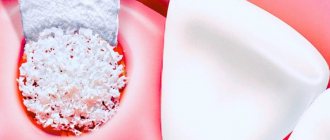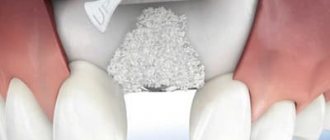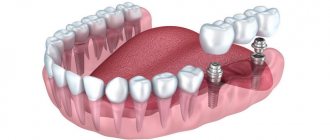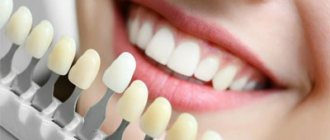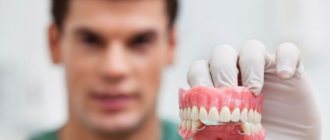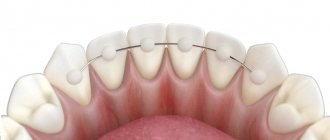Osseointegration in dental implantation is the process of engraftment of a dental implant into bone tissue. If the effect is positive, the jaw bone “accepts” the metal artificial root, does not reject the foreign body, and subsequently functions normally.
The very concept of “osseointegration of an implant” became popular at the end of the 20th century, when implantology began to actively develop in modern dentistry. This process was first discussed in 1965, when Swedish scientists studied the process of bone tissue regeneration after human injuries.
Factors influencing the success of osseointegration
The success of implantation of an artificial root depends on:
- initial diagnosis;
- type and quality of the implant;
- surgical technique during surgery;
- surfaces and shapes of artificial roots;
- individual characteristics of the body;
- presence of allergies;
- patient's age;
- general condition of the oral cavity;
- past diseases, etc.
Important! The body’s successful “response” to the introduction of an artificial root is not a 100% guarantee of the success of the entire implantation process, although it is objectively considered a key point. In some cases, even with successful osseointegration, the location for installing the implant may be poorly chosen, or a low-quality prosthesis may have been selected.
The secret of success is in the surface of the implant
Research has proven that the best material for implants is titanium, with porous coating having an advantage over smooth coating. Thanks to the rough coating of the part, a number of positive changes occur in the body, and the area of bone integration increases.
For this reason, manufacturers of implants for dental prosthetics prefer the following coatings:
- Bioactive porous powder coating that accelerates the formation of bone tissue inside the implant.
- Implants with plasma hydroxyapatite or tricalcium phosphate coating. In this case, bone formation is stimulated through the use of inorganic components of bone tissue, which gradually dissolve.
The most popular are products with SLA or RBM coating. They have appropriate markings, which dental technicians are guided by. In the first case, a porous surface is achieved by sandblasting and acid. In the second - treatment with beta-tricalcium phosphate particles and etching in low concentration organic acid.
In addition to the implant material and its surface texture, osseointegration depends on the quantity and quality of bone at the site of implantation. If the bone is not damaged or atrophied, the structure will stand stably, and the bone tissue will regenerate faster. The larger the area of the implant in contact with the bone, the faster its successful engraftment.
Despite some complexity of the processes that occur in the body when a foreign body is implanted, patients have no reason to panic. Modern prosthetic products are made from biocompatible materials, and cases of their rejection are practically reduced to zero. So, feel free to trust professional dentists and enjoy the benefits of new teeth.
The material and shape of the implant play a role
For successful engraftment into the bone, the artificial root material must be inert so as not to cause a negative reaction from the body. The following materials meet this requirement:
- bioinert – titanium alloy, zirconium, titanium nickelide, gold, etc.
- biotolerant - an alloy of chromium and cobalt;
- bioactive - metal coated with a calcium phosphate or ceramic layer, porous coating.
Based on the experience of introducing artificial roots, and the general statistics of implant engraftment, the following are considered the best:
- screw
- cylindrical;
- in the shape of a natural tooth;
- with cortical overlays, etc.
Main stages of osseointegration
- Before implantation, the patient’s bone tissue is examined: structure, density, volume, structure, etc. The level of tissue resorption, the ratio of spongy substance and the so-called cortical plate are determined;
- If the bone volume is not enough, augmentation or sinus lift is performed. All this is done to avoid mechanical overload, which can negatively affect the process of root engraftment.
- After insertion, the implant should not be loaded to avoid the formation of a fibrous capsule.
- After 3 to 6 months, the trabecular bone begins to strengthen. In general, it takes about one and a half years for complete and final strengthening of the bone. But, if after six months the process is successfully completed, the new root can be safely loaded with a crown.
- 5. During this period, it is important to be observed by the treating dentist in order to monitor the process visually and using special equipment. If necessary, the specialist will prescribe a course of treatment to speed up and improve the quality of bone integration.
Note! The first two to three weeks after root penetration are indicative for its engraftment. It is in the first days that the so-called trabecular bone is formed around the pin. That is why a crown is not placed on the root, so as not to disrupt the primary process of osseointegration.
The good news is that modern technologies provide high guarantees of successful implantation. In order for the root to take root quickly, it is important:
- install an implant from a trusted manufacturer;
- seek help from an experienced implant dentist who specializes in installing artificial roots;
- follow the recommendations after implantation of the root (regularly brush your teeth, follow a diet, do not load the operated area, stop drinking alcohol and smoking).
Osseointegration in dental implantology - what is it?
Osseointegration is the establishment of contact between the surface of the structure and the jaw bone. Successful integration requires:
- high-quality implant;
- sufficient volume of bone tissue;
- compliance with implantation technology.
Strong retention of the implant in the bone is ensured by a microscopic surface. When bone cells interact with the uneven surface of a structure made of titanium, a geometric bone structure forms around it. This determines the stability of the artificial root.
Placement of an implant in the jaw is accompanied by distant and contact osteogenesis. These are processes that allow bone tissue to reach the surface of the structure and spread on it. Remote osteogenesis is involved in bone regeneration. Contact osteogenesis is necessary to form bone tissue on the surface of the artificial root. It is based on the migration of osteogenic cells on the surface, in which the fibrin fibers of the blood clot take part.
If the patient has bone resorption, osteoplasty is required. Extension will provide the required volume.
Osseointegration is also affected by:
- physician experience;
- compliance with postoperative recommendations.
Complications of unsuccessful osseointegration
The most common complication is reimplantitis, that is, inflammation around the implanted artificial root. With this diagnosis, the bone tissue gradually decreases, and eventually the root is rejected. The problem arises due to an accidental infection in the socket, improper oral care after implantation, heavy load or trauma to the bone, excessive size of the bone bed and other factors.
To correct the condition, the implant is removed from the socket, the abscess and gum pocket are removed. The gums are treated with an antibacterial composition, and physiotherapy is prescribed to restore soft tissues. After a few months, re-implantation is scheduled.
How to choose a clinic in Moscow to guarantee successful osseointegration?
The 32 Dent clinic chain specializes in dental implantation. That is why, according to statistics, 32 Dent patients have almost 100% successful osseointegration. High-quality implants made in Israel, Switzerland, the USA, the work of experienced specialists, modern equipment - all this is the key to the successful implantation of a new tooth. You should make sure of this by making an appointment with an implantologist now!
If you have a problem similar to that described in this article, be sure to contact our specialists. Don't diagnose yourself!
Why you should call us now:
- We will answer all your questions in 3 minutes
- Free consultation
- The average work experience of doctors is 12 years
- Convenient location of clinics
Single contact phone number: +7
Make an appointment
Sources:
- Personal experience as an implant dentist;
- Vorobyov, A. A. A look at the problem of dental implantation in the light of modern scientific ideas / A. A. Vorobyov, V. I. Shemonaev, D. V. Mikhalchenko, A. S. Velichko // Volgograd Medical Scientific Journal. - 2009;
- Sirak, S. V. Direct dental implantation in patients with included dentition defects / S. V. Sirak, A. A. Sletov, K. S. Gandylyan, M. V. Dagueva // Medical Bulletin of the North Caucasus. - 2011;
- Esposito, M. Interventions for replacing missing teeth: different types of dental implants / M. Esposito, Y. Ardebili, H.V. Worthington // Cochrane Database Syst. Rev. - 2014;
- Dental implants are a viable alternative for compensating oligodontia in adolescents / S. Heuberer, G. Dvorak, C. Mayer, G. Watzek, W. Zechner // Clin. Oral Implants Res. — 2015;
- Immediate loading implants: review of the critical aspects / L. Tettamanti, C. Andrisani, MA Bassi, R. Vinci, J. Silvestre-Rangil, A. Tagliabue // Oral Implantol. — 2017;
- Paraskevich, V. L. Dental implantology: basic theory and practice / V. L. Paraskevich. - Minsk: Unipress, 2002;
- Labis, V.V. The role of the bacterial factor and the immune system in the process of reparative osteogenesis during dental implantation / V.V. Labis, E.A. Bazikyan, I.G. Kozlov // Bulletin of the Orenburg Scientific Center of the Ural Branch of the Russian Academy of Sciences. - 2013;
- Aleinikova, E. V. Modern concept of osseointegration of dental implants / E. V. Aleinikova, A. B. Shabanovich // Medical journal. - 2006;
- The influence of physicochemical properties of the surface of titanium implants and methods of their modification on osseointegration indicators / G. A. Volozhin, A. P. Alekhin, A. M. Markeev, D. V. Tetyukhin, E. N. Kozlov, M. A. Stepanova // Institute of Dentistry. — 2009.
Different approaches to solving the problem of missing teeth
The absence of teeth in the dental arch is either a congenital defect or a consequence of caries and periodontal disease. It is obvious that restoration of missing teeth is not always necessary, but in many cases it is desirable to improve aesthetics, chewing function or speech, and sometimes to prevent various disorders, such as dentoalveolar protrusion of antagonist teeth towards the defect (Popov-Godon phenomenon ) or an abnormal position of the teeth in the dentition. Tooth loss is usually followed by alveolar ridge atrophy, which further exacerbates bone deficiency.
In most countries with a developed dental service, the bulk of the work of dentists is aimed at preventing tooth loss, restoring dental defects, and replacing missing teeth along with supporting tissues. When working with edentulous patients, treatment in most cases is limited to the manufacture of a complete removable denture; whereas, if only part of the teeth are missing, the possible treatment options are more varied and there are many ways to fix dentures in the mouth to the remaining natural teeth. Removable partial dentures are acceptable in a wide variety of clinical situations, so they are widely used and, under suitable conditions for their application, can achieve good long-term results. However, they cause certain inconvenience to patients due to their significant size and the presence of metal parts, which are sometimes difficult to disguise. They are distinguished by less stability in the oral cavity in comparison with fixed bridges, firmly fixed to the supporting teeth. Fixation of dentures can be carried out after significant preparation of the tissues of the supporting teeth or using a more modern and gentle option - adhesive technologies. Typically, partial removable dentures are used to replace defects in the dentition of considerable extent, with a significant loss of alveolar bone, and also in cases where their main positive qualities are of greatest importance: the relative ease of manufacture and fixation. The widespread use of fixed dentures is limited by more stringent requirements for the existing conditions in the oral cavity; such dentures are more expensive, but they have a number of positive qualities associated with greater stability and smaller volumes of the structure.
For a long time, clinicians have been looking for the opportunity to provide their patients with an artificial analogue of natural teeth; for this it was proposed to use many different materials and technologies. However, due to the impossibility of restoring the periodontal ligament, an alternative strategy was adopted, based on the principles of creating and maintaining a specific type of connection between the implant and the bone tissue. This connection ensures the transfer of stress to the bone tissue, and, when created in healthy tissue, allows for a high percentage of success. The possibility of achieving such results seemed very doubtful before the discovery of the phenomenon of osseointegration.
Osseointegration
Extensive research by the Swedish researcher P.-I.Brånemark made it possible to make the discovery that industrial pure titanium, introduced into specially prepared bone tissue, forms a strong connection with it (Fig. 1). This phenomenon was later called osseointegration (OI). This type of connection has anatomical and functional significance, as it requires close contact of the implant with the surrounding bone tissue and the ability to transfer functional loads for a long time without any systemic changes or local negative reactions from surrounding tissues. If the implant normally bears a functional load, then it is impossible to check whether an OA has actually occurred or not, since there are no manifestations indicating this. Many factors that contribute to OI are now known, and if they are present, the likelihood of successful placement of an appropriate implant for a given situation increases. In the same way, there are cases when one of the implants placed on a patient does not take root without any apparent reason - this is the so-called cluster phenomenon.
Rice. 1.
The key point in osseointegration, as well as a functionally very important parameter, is the tight contact of the surfaces of the implant and living bone.
Therefore, it is very important to inform the patient that it is impossible to 100% guarantee a positive result.
OI should be considered as achieving optimal interaction between the bone and the surface of the implant, without which success is impossible; therefore, the main emphasis is on creating this interaction and maintaining it in the future. Although important, it is only one component of successful implantation and does not in itself eliminate failure. Although the absence of OR results in failure, even achieving OR does not in itself guarantee success, since the design of the permanent prosthesis is a very important factor. Failure may also be due to the wrong choice of place to install the implant, even with good OI.
Although an integrated implant and its surrounding mucosa are often considered to be analogous to a tooth, there are a number of differences between them. It is especially important that the integration zone is more rigid and less elastic than the periodontal ligament.
The stability of the connection between the implant and the bone tissue prevents its movement during orthodontic treatment, however, the implant can be used as a support for a fixed orthodontic appliance. The presence of an integration zone causes a low level of alveolar bone loss - usually less than 0.1 mm in the first year after implantation. Thus, most implants can presumably function for a lifetime.
Sometimes an inflammatory reaction occurs around endosseous implants; the inflammatory process can only affect the soft tissue surrounding the implant, however, with the loss of bone tissue in the area of the joint, we are talking about peri-implantitis. Due to the fact that the microorganisms sown in this case are similar to the microflora during periodontitis, it is still not clear whether the development of peri-implantitis is associated with their presence or whether they inoculate the affected area in the future.
Factors influencing the process of osseointegration
Successful implant integration depends on a number of general and local factors. Some common factors whose significance turned out to be greater than expected will be discussed below. Local factors include the following.
Material
Initially, it was believed that the unique phenomenon of OI was possible due to the material used - high-quality titanium (industrial pure titanium. 99.75%). This material is still the basis of the technology, although a number of other materials are known that can also form a strong connection with bone. These include zirconium, some ceramic materials, and especially hydroxyapatite, although it has not been as well studied as titanium as an implant material.
Composition and surface structure
Titanium is believed to be capable of integration due to its ability to quickly form a persistent and relatively inert oxide layer on the surface. This surface has been described as osteoconductive, i.e. promoting bone formation. Other materials also have OI properties and can stimulate bone formation. Although the initial bond between the bone surface and the implant of these materials can be formed more intensely and faster than around a titanium implant, good long-term results have not been proven by studies. However, there is considerable interest in modeling an implant from a material that would achieve ROI faster and/or have any mechanical or clinical superiority of the implant (Figure 2).
Rice. 2.
Manufacturers produce implants with a modified surface to improve the integration process. Shown is the surface of a TiUnite implant used by Nobel Biocare (courtesy of Prof. N.Meredith).
Overheating
Overheating bone to temperatures above 47°C during surgery can lead to cell death and collagen denaturation. Because of this, instead of achieving true ROI, a fibrous capsule is formed around the implant and the strength of its connection to the bone is significantly reduced. Therefore, care should be taken to prevent overheating of the bone during the preparation of the bone bed for the implant, which depends on the speed of rotation of the drill, its shape, the amount of bone removed at one time, the density of the bone tissue and the cooling used.
Ideally, it is recommended to use low-speed drills with generous irrigation to cool them.
Contamination
Contamination of the bone bed for the implant with organic and inorganic particles can prevent OI. In this regard, the remains of necrotic tissue, microorganisms, chemicals, as well as small particles that break off from the drill are particularly dangerous.
Primary stability
It is known that achieving OI is most likely when the implant “sits” tightly in the prepared bone bed. This is often defined as primary stability of the implant, and if this can be achieved, the likelihood of an unsatisfactory treatment outcome is reduced. Primary stability depends on the quality of implant installation, its shape, structure and bone density. Thus, it is much easier to achieve stability when working with screw implants than with implants that do not have a pronounced surface relief. A bone bed formed in soft, coarse bone tissue with loose cortical plate will not provide sufficient primary stability. To solve this problem, some manufacturers produce self-tapping implants.
Bone quality
This characteristic of bone is well understood by clinicians, but it is much more difficult to describe scientifically. Quality depends on bone density, its anatomical structure and quantity, and a number of indices are used to describe this characteristic. The most widely used classifications to describe the quality and quantity of bone tissue are Lekholm and Zarb, Cawood and Howell (Fig. 3, 4). The first classification is based on the ratio of the amount of cortical plate and cancellous bone and their density, and the second on the degree of bone resorption. The volume of bone tissue as such does not affect the ROI, but this indicator is very important for implant fixation. If the volume of bone tissue is insufficient, then there is a risk of mechanical overload, and therefore an unsatisfactory treatment result, so in such a case a small implant should be used.
Rice. 3.
Options for the bone structure of edentulous jaws: (1) thick compact plate and loose spongy substance; (2) a thin compact plate and a lot of loose spongy matter; (3) a dense, compact lamina with minimal volume of cancellous bone; (4) thin compact plate and sparse spongy substance. Any of these options can provide the necessary conditions for implant fixation, but options 1 and 3 have a high risk of thermal injury, and options 2 and 4 often have problems achieving primary stability.
Rice. 4
. Classification of bone resorption in the upper and lower jaws with complete edentia. (Quoted in Cawood and Howell, 1988.)
Epithelial sprouting
The design disadvantage of the first implants was the ingrowth of the epithelium of the oral mucosa into the interior. With the advent of a new generation of implants made of industrial pure titanium, in order to prevent germination, they began to cover the implant with a mucous flap for the duration of surgery. Once the process is complete, the implant is opened and the superstructure is installed, since the integrated surface is known to be resistant to epithelial ingrowth. Recently, interest has begun to increase in the use of implants that penetrate the mucosa immediately from the moment of installation.
Although this technique has not been proven in long-term studies compared to earlier methods, based on preliminary studies it appears to be effective and successful when used in appropriate patients. This technique allows the installation of a prefabricated superstructure on implants immediately after they are installed in the bone tissue.
Early load
Scientific studies have shown that if the implant is subjected to high loads immediately after installation, OA does not occur, and a fibrous capsule forms around the implant. However, it is known from clinical practice that if the implant has good primary stability, then moderate loads do not interfere with OR.
Late load
It has been found that excessive mechanical stress on the implant can lead to destruction of the integration zone and loss of the implant, so overload should be avoided. The causes of significant loads can be bruxism, bad habits, as well as the design of the superstructure, in which excessive load falls on it. The scientific basis for the connection between chewing load and destruction of the OA zone is not so significant. At present, there is no clinical evidence that exercise is more likely to underlie impairment of OI than any other cause. Bone tissue is very sensitive and can undergo restructuring under the influence of deformations; this quality can be used for therapeutic purposes.
Guide to dental implantology. John A. Hobbeck, Roger M. Watson, Lloyd J.J. Sizn
Published by Konstantin Mokanov
